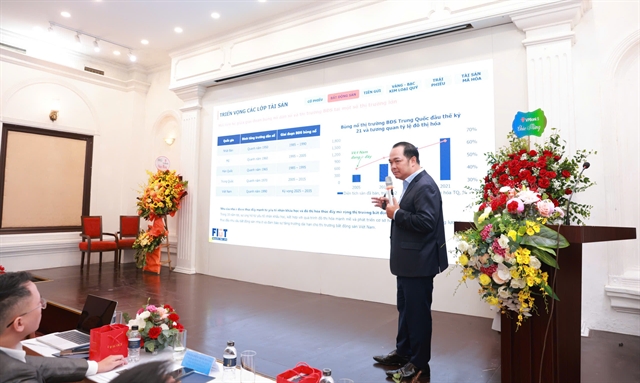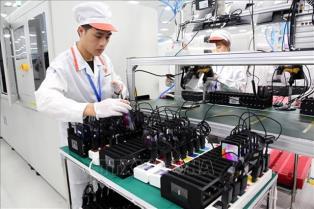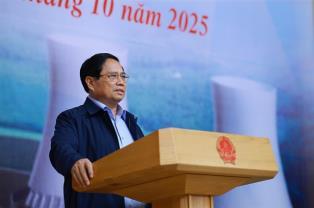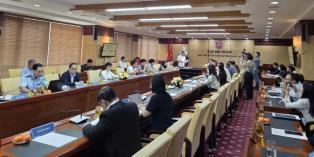During the 2022–2024 period, Việt Nam saw a strong recovery, with GDP growth rebounding to 8 per cent in 2022 and 7.1 per cent in 2024, and projected at 8.5 per cent in 2025.

HÀ NỘI — At the 2026 Business Forum themed 'Opportunities and Strategies of GDP growth', experts highlighted that Việt Nam's economy is aligning with several favourable conditions to make the ambitious target of double-digit GDP growth increasingly feasible.
At the forum, organised by Bizlive on October 22, Huỳnh Minh Tuấn, founder of FIDT Investment Consulting and Asset Management JSC (FIDT) and vice chairman of APG Securities, emphasised that Việt Nam is entering a new growth cycle, targeting an average GDP growth rate of 10 per cent per year during the 2026–2030 period.
According to Tuấn, Việt Nam's economy has experienced three distinct phases over the past few decades, including stable growth at 6.5–7 per cent annually during 2015–2019; and a significant slowdown due to the COVID-19 pandemic, with GDP growth dropping to 2.9 per cent in 2020 and 2.6 per cent in 2021.
During the 2022–2024 period, Việt Nam saw a strong recovery, with GDP growth rebounding to 8 per cent in 2022 and 7.1 per cent in 2024, and projected at 8.5 per cent in 2025.
Looking ahead, from 2026 to 2030, the nation is projected to enter a high-growth phase, aiming for 10 per cent annual GDP growth.
This ambitious target is supported by institutional reforms, increased public investment, rising labour productivity, and effective use of foreign direct investment (FDI) shifting into Việt Nam, Tuấn said.
He noted that Việt Nam has several advantages, such as improved investment transparency, flexible governance policies, and strengthening trade relationships with major partners - especially with the US.
A large-scale public investment plan for 2025–2030 is expected to serve as a catalyst for growth across key sectors such as infrastructure, manufacturing, logistics, and renewable energy.
The private sector is also recognised as a central growth engine. In 2025, several pivotal resolutions have been issued to expand opportunities for private enterprises and startups.
Among them, Resolution 68-NQ/TW affirmed the private sector as a key driver of economic development. It aims to establish two million efficient enterprises by 2030, with at least 20 reaching global stature.
This resolution emphasises institutional reform, a better investment environment, and stronger linkages among private firms, FDI companies, and state-owned enterprises.
Subsequently, the National Assembly and Government enacted specific policies through Resolution 198/2025/QH15 and Resolution 138/NQ-CP, including corporate income tax exemptions for the first two years and a 50 per cent tax reduction for the next four years for innovative startups.
The policies also include the creation of the Việt Nam Private Enterprise Development Fund and the expansion of green credit channels to support enterprise funding.
Meanwhile, Resolutions 139/NQ-CP and 57-NQ/TW focus on workforce training, supporting industries, digital transformation and the start-up ecosystem - key to boosting productivity, competitiveness, and global integration.

The FIDT representative said that with strategic execution in institutional reform, energy transition, digital technology adoption, and deeper global integration, the country could realise its 10 per cent GDP growth target and join Asia's most dynamic economies.
Nguyễn Việt Đức, Digital Business Director at VPBankS, referenced the IMF’s September forecast, which projects Việt Nam’s GDP growth at 6.5–6.7 per cent - a figure based on conventional fiscal and monetary policy assumptions.
He pointed out that the government has set higher targets, with the State Bank aiming for 16–17 per cent credit growth.
For the remainder of 2025, Đức expects credit growth to rise to as much as 19 per cent, supported by a stronger monetary push and major public investment disbursement.
The early conclusion of a reciprocal tariff agreement with the US is already driving export performance beyond expectations. While many experts predicted a 10 per cent drop in exports for 2025, actual figures are showing a 17 per cent increase - significantly boosting GDP.
Đức said: “Việt Nam has done remarkably well this year, but 2026 might not be as strong. We should approach it with some caution.”
He explained that export growth has started slowing in recent months, and corresponding tax revenues are beginning to decline. Meanwhile, credit growth is expected to moderate to around 16 per cent.
Public investment, however, will remain a strong driver, with an expected increase of 32–33 per cent - supported by Việt Nam’s still-manageable public debt levels currently rising by just 32 per cent, lower than in most emerging markets.
He also noted that upcoming reforms in digital currency and crypto asset regulation could provide new economic momentum.
Digital economy
The digital economy is increasingly seen as a key driver of future growth. Among the areas gaining traction are crypto assets. Nghiêm Minh Hoàng, Economic-Financial Expert at the Việt Nam Blockchain and Digital Assets Association (VBA), shared that digital assets and Resolution 05 are among the most closely watched developments heading into 2026.
VBA has long advocated collaboration with regulatory agencies. However, as the pilot implementation of Resolution 05 nears, the association is taking a more cautious stance.
The resolution outlines a framework for four key stakeholder groups: crypto-asset exchange operators, regulators, domestic and foreign investors and token issuers.
Crypto assets, including cryptocurrencies and tokens, are also projected to account for about 5 per cent of portfolios by 2030, as awareness and investor appetite increase, said Tuấn from FIDT.
As Việt Nam’s economy accelerates, a blend of traditional and emerging investment avenues is becoming more attractive to investors, he said.
Real estate continues to dominate, driven by ownership culture, economic growth, urbanisation, infrastructure expansion and incoming FDI.
According to FIDT, real estate currently makes up 60 per cent of personal asset portfolios in Việt Nam and is expected to remain high at around 50 per cent by 2030.
Gold remains a popular choice due to its inflation-hedging properties, liquidity, and safe-haven status, maintaining a 5 per cent share of total assets through 2025–2030.
Stocks are set to see increased allocation - from 15 per cent in 2025 to 20 per cent in 2030 - thanks to rising public interest, high liquidity, and strong returns. Similarly, bonds are regaining appeal as yields begin to outpace savings interest rates, expected to double from 5 per cent in 2025 to 10 per cent by 2030.
On the other hand, savings deposits, which currently hold a significant share of household assets, are likely to decline - from 15 per cent in 2025 to 10 per cent in 2030 - due to low interest rates and rising interest in higher-yielding investments. — VNS





